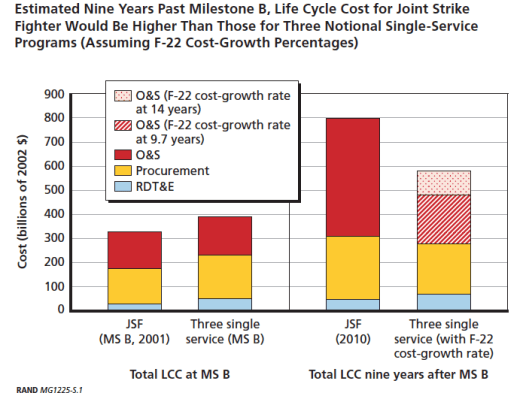An F-35 Lightning II flies over northwestern Florida.
The good news is that someone finally did a study to see if one-size-fits-all-services warplanes actually save the taxpayers money.
The bad news is that the answer is no.
The even badder news is that the Pentagon’s most costly weapons system ever—the F-35 Joint Strike Fighter, which last week delivered the 100th of an expected run of 2,457 fighters for $400 billion—is precisely that kind of fighter. You, your children, and grandkids will apparently be paying more for it than they should for decades to come.
But despite such grim tidings this holiday season, that’s actually not the worst news in that new report from the Rand Corp. That would be this:
Although there have been many analyses of the potential savings from joint aircraft programs, there have been no comprehensive analyses of actual outcomes based on cost data from historical joint aircraft programs.
In other words, the Pentagon (with congressional help) has routinely been saying “trust us” when it comes to such procurements, but never following up to see if that trust is warranted.
For the past 50 years, the study says, such programs were “thought to save significant Life Cycle Cost (LCC) by eliminating duplicate efforts and realizing economies of scale.”
Turns out not to be true.
Granted, comparing complicated machines built decades apart is challenging. But before launching the F-35 program, the Pentagon had already developed such multi-service aircraft (or tried to) including the F-111, the A-7 and the F-4. You might think that proving the key reason for developing a joint warplane—to save money—would be elementary due diligence before launching a $400 billion program to develop a joint warplane.
The Rand study—Do Joint Fighter Programs Save Money?—finds that promise unfulfilled. “Although joint aircraft programs do, in theory, save costs by sharing RDT&E [research, development, test, and evaluation] resources, increasing production runs, and utilizing economies of scale in O&S [operations and support], these savings are too small to offset the substantial additional average cost growth historically observed in the acquisition phase,” Rand concludes. “Historical joint aircraft programs have not yielded overall LCC savings compared with single-service programs.”

The two bars on the left show cost estimates at the start of the programs, with the joint warplane cheaper. The two bars on the right show how nine years later, the joint program has become more costly than single-service warplanes.
In the several programs surveyed, Rand reports that the cost of buying a joint airplane grew by 65%, compared to 24% for single-service aircraft, in the nine years following the beginning of full-scale development (known as “Milestone B” inside the Pentagon, and selected to help make comparisons among different aircraft uniform). The F-35, Rand estimates, will cost about $800 billion by that point; three separate aircraft would have cost less than $600 billion, a savings of roughly 25%.
But that’s only the money. The real danger of relying on a single aircraft is that it could endanger its pilots. “During the Korean War, the U.S. Air Force was able to rapidly upgrade one of its four jet fighters, the F-86 Sabre, to meet the surprise introduction of the Russian Mikoyan-Gurevich (MiG)-15, a Soviet-designed fighter that was more capable than any other U.S. fighter in the Air Force or Navy inventory,” Rand says. “Had the Air Force and Navy relied exclusively on a single joint fighter other than the F-86, it might not have been able to respond quickly to the unanticipated new threat posed by the MiG-15.”
The fundamental challenge of building a multi-service fighter is that one size doesn’t fit all in the war-fighting business. “They are separate airplanes,” Thomas Christie, the Pentagon’s chief weapons tester from 2001 to 2005, told Time earlier this year of the F-35’s three variants. “We would have been better off if we’d let the services go off and do their own thing.” A bonus would have been multiple plane builders—instead of a single contractor—to keep the companies on their toes, he added.
In the case of the Lockheed-built F-35, the Air Force placed a premium on stealth and speed, the Navy needed an airframe that could handle punishing carrier operations, and the Marines demanded a plane that could land vertically on its amphibious ships. What began more or less as a single blueprint for all three versions has turned into three ever-changing sets of drawings for three very different fighters.
“The idea that we could produce a committee design that is good for everybody is fundamentally wrong,” said Merrill McPeak, the Air Force chief of staff from 1990 to 1994. ” “If the services can all use the same piece of major combat equipment, then you have to wonder why the services are separate.”
The Rand report confirms Christie’s and McPeak’s gut feelings. “From the Tactical Fighter, Experimental (TFX)/F‑111 program in the 1960s through the [F-35] JSF program today, the attempt to accommodate multiple operating environments, service-specific missions, and differing performance and technology requirements in common joint fighter designs has increased programmatic and technical complexity and risk, thus prolonging RDT&E and driving up joint acquisition costs,” it says. “At the same time, service-specific requirements and demands tend to produce less commonality and lead to more variants, thus reducing the main source of joint cost savings anticipated in procurement and O&S.”
Rand’s bottom line—a day late, and $400 billion short—is that the Pentagon should “avoid future joint fighter and other complex joint aircraft programs.”

